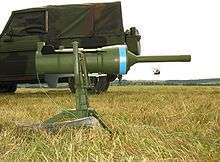PARM 1 mine
The PARM 1 (DM-12) and PARM 2 are German off-route mines that fire small fin stabilized rockets.

Development
The mine was developed in the early 1980s to meet the US MIL-STD-331A and US MIL-STD-810C requirements. Trials of the mine were conducted between March 1983 and March 1988. In June 1988 it was accepted into service with the German army, with the Army receiving the first batch of 25,000 between 1991 and 1994. The PARM 2 was a development of PARM 1 incorporating an infra-red sensor, and an improved rocket.
PARM 1
The PARM 1 is mounted on a small tripod, allowing it to be traversed through 360 degrees and elevated to 90 degrees and depressed to -45 degrees. The mine is manually emplaced, and incorporates an arming delay of five minutes. It can be either command detonated or by a fibre optic trigger cable, which triggers the mine when it is crushed.
The mine has an effective range of between 2 and 40 metres. The rocket has a velocity of approximately 120 metres per second, and has a claimed armour penetration of 600 millimeters.
PARM 2
The PARM 2 incorporates an infra-red sensor, the SAPIR, which acts to accurately fire the rocket to ranges up to 100 meters. The warhead of the PARM 2 has been upgraded, with an armour penetration of 750 millimeters and a capability against reactive armour. It can be programmed to be active from between hours and 30 days.
Specifications
| Model | PARM 1 | PARM 2 |
|---|---|---|
| Length | 640 mm | ? |
| Height | 391 mm | 300 to 700 mm |
| Warhead diameter |
132 mm | 110 mm |
| Weight | 10 kg | 20 kg |
| Warhead | 1.4 kg | 1.9 kg |
| Range | 2 to 40 m | 4 to 100 m |